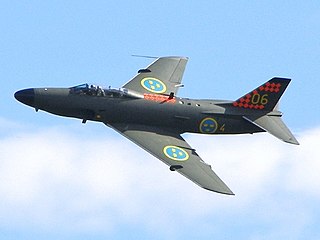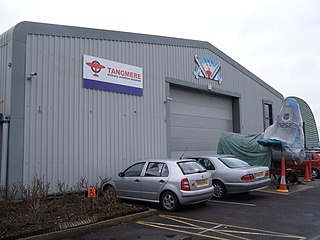
The Gloster Meteor was the first British jet fighter and the Allies' only jet aircraft to engage in combat operations during the Second World War. The Meteor's development was heavily reliant on its ground-breaking turbojet engines, pioneered by Frank Whittle and his company, Power Jets Ltd. Development of the aircraft began in 1940, although work on the engines had been under way since 1936.

The Westland Whirlwind was a British twin-engined fighter developed by Westland Aircraft. A contemporary of the Supermarine Spitfire and Hawker Hurricane, it was the first single-seat, twin-engined, cannon-armed fighter of the Royal Air Force.

The Hawker Hunter is a transonic British jet-powered fighter aircraft that was developed by Hawker Aircraft for the Royal Air Force (RAF) during the late 1940s and early 1950s. It was designed to take advantage of the newly developed Rolls-Royce Avon turbojet engine and the swept wing, and was the first jet-powered aircraft produced by Hawker to be procured by the RAF. On 7 September 1953, the modified first prototype broke the world air speed record for aircraft, achieving a speed of 727.63 mph.

The Folland Gnat is a British compact swept-wing subsonic fighter aircraft that was developed and produced by Folland Aircraft. Envisioned as an affordable light fighter in contrast to the rising cost and size of typical combat aircraft, it was procured as a trainer aircraft for the Royal Air Force (RAF) as well as by export customers, who used the Gnat in both combat and training capacities.

The Saab 32 Lansen is a two-seat, transonic military aircraft designed and manufactured by the Swedish aircraft manufacturer Saab AB.

The Supermarine Attacker is a British single-seat naval jet fighter designed and produced by aircraft manufacturer Supermarine for the Royal Navy's Fleet Air Arm (FAA). It was the first jet fighter to enter operational service with the FAA.

The Hawker Sea Hawk is a British single-seat jet day fighter formerly of the Fleet Air Arm (FAA), the air branch of the Royal Navy (RN), built by Hawker Aircraft and its sister company, Armstrong Whitworth Aircraft. Although its design originated from earlier Hawker piston-engined fighters, the Sea Hawk was the company's first jet aircraft.

The Hawker Fury is a British biplane fighter aircraft used by the Royal Air Force in the 1930s. It was a fast, agile aircraft, and the first interceptor in RAF service capable of speed higher than 200 mph in level flight. It was the fighter counterpart to the Hawker Hart light bomber.

The Rolls-Royce RB.41 Nene is a 1940s British centrifugal compressor turbojet engine. The Nene was a complete redesign, rather than a scaled-up Rolls-Royce Derwent, with a design target of 5,000 lbf (22 kN), making it the most powerful engine of its era. First run in 1944, it was Rolls-Royce's third jet engine to enter production, and first ran less than 6 months from the start of design. It was named after the River Nene in keeping with the company's tradition of naming its jet engines after rivers.

The Rolls-Royce Avon was the first axial flow jet engine designed and produced by Rolls-Royce. Introduced in 1950, the engine went on to become one of their most successful post-World War II engine designs. It was used in a wide variety of aircraft, both military and civilian, as well as versions for stationary and maritime power.

The Armstrong Siddeley Sapphire is a British turbojet engine that was produced by Armstrong Siddeley in the 1950s. It was the ultimate development of work that had started as the Metrovick F.2 in 1940, evolving into an advanced axial flow design with an annular combustion chamber that developed over 11,000 lbf (49 kN). It powered early versions of the Hawker Hunter and Handley Page Victor, and every Gloster Javelin. Production was also started under licence in the United States by Wright Aeronautical as the J65, powering a number of US designs. The Sapphire's primary competitor was the Rolls-Royce Avon.

The Supermarine Spiteful was a British fighter aircraft designed by Supermarine during the Second World War as a successor to the Spitfire. Powered by a Rolls-Royce Griffon engine, it had a radical new wing design to allow safe operations at higher speeds and incorporating inwards-retracting undercarriage. Other changes included a larger fin to improve the marginal stability of Griffon Spitfires. Development of the wing was formalised by Air Ministry specification F.1/43; as well as a new aircraft, there was an expectation the wing could be used as a replacement for the elliptical wing on Spitfire production.

The Hawker P.1081, also known as the "Australian Fighter" was a prototype British jet aircraft from the mid-twentieth century. The single example built was destroyed in a crash in 1951.

The Dassault MD.454 Mystère IV is a 1950s French fighter-bomber aircraft, the first transonic aircraft to enter service with the French Air Force. It was used in large-scale combat in the Israeli Air Force during the 1967 Six Day War.

The following is a list of variants of the Hawker Hunter fighter aircraft:

The Tangmere Military Aviation Museum is a museum located on the former site of RAF Tangmere, West Sussex. The museum was opened in June 1982. Many aerospace exhibits covering the First World War to the Cold War are on display including fixed-wing aircraft, helicopters and aircraft engines.

The CAC Sabre, sometimes known as the Avon Sabre or CA-27, is an Australian variant of the North American Aviation F-86F Sabre fighter aircraft. The F-86F was redesigned and built by the Commonwealth Aircraft Corporation (CAC). Equipping five RAAF squadrons, the type saw action in the Malayan Emergency in the late 1950s, and was employed for air defence in Malaysia and Thailand in the 1960s. Ex-RAAF models also saw service with the Royal Malaysian Air Force and the Indonesian Air Force.

The Rolls-Royce Griffon engine was designed in answer to Royal Navy specifications for an engine capable of generating good power at low altitudes. Concepts for adapting the Spitfire to take the new engine had begun as far back as October 1939; Joseph Smith felt that "The good big 'un will eventually beat the good little 'un." and Ernest Hives of Rolls-Royce thought that the Griffon would be "a second power string for the Spitfire". The first of the Griffon-engined Spitfires flew on 27 November 1941.

The Hawker P.1121 was a British supersonic fighter aircraft designed, but never fully completed, by Hawker Siddeley during the mid-1950s. It was designed by a team headed by Sir Sydney Camm.

The Supermarine 545 was a supersonic jet fighter project designed by the British aircraft manufacturer Supermarine. A single aircraft was built, but remained unflown, largely due to the project having fallen out of political favour.




























